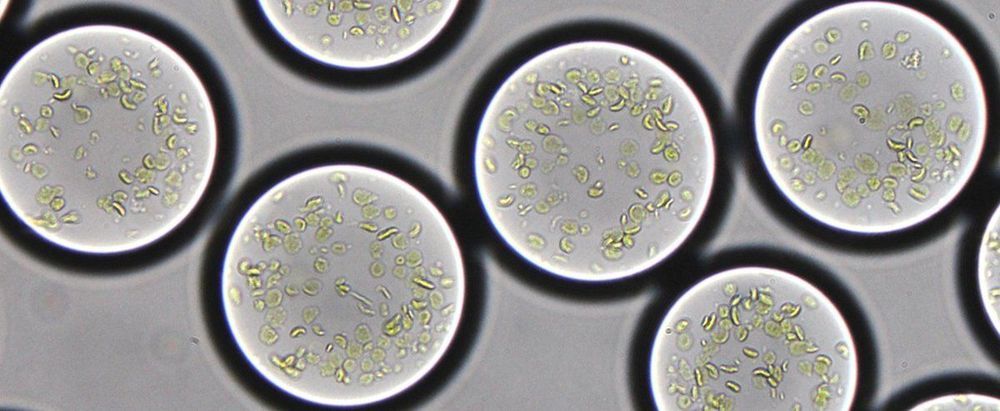Page 7457
May 15, 2020
Quantum Entanglement of 15 Trillion Atoms at 450 Kelvin With “Surprising Results”
Posted by Quinn Sena in categories: computing, particle physics, quantum physics
Quantum entanglement is a process by which microscopic objects like electrons or atoms lose their individuality to become better coordinated with each other. Entanglement is at the heart of quantum technologies that promise large advances in computing, communications and sensing, for example detecting gravitational waves.
Entangled states are famously fragile: in most cases even a tiny disturbance will undo the entanglement. For this reason, current quantum technologies take great pains to isolate the microscopic systems they work with, and typically operate at temperatures close to absolute zero. The ICFO team, in contrast, heated a collection of atoms to 450 Kelvin, millions of times hotter than most atoms used for quantum technology. Moreover, the individual atoms were anything but isolated; they collided with each other every few microseconds, and each collision set their electrons spinning in random directions.
The researchers used a laser to monitor the magnetization of this hot, chaotic gas. The magnetization is caused by the spinning electrons in the atoms, and provides a way to study the effect of the collisions and to detect entanglement. What the researchers observed was an enormous number of entangled atoms — about 100 times more than ever before observed. They also saw that the entanglement is non-local — it involves atoms that are not close to each other. Between any two entangled atoms there are thousands of other atoms, many of which are entangled with still other atoms, in a giant, hot and messy entangled state.
May 15, 2020
Researchers develop an artificial chloroplast
Posted by Shailesh Prasad in categories: biotech/medical, chemistry, food, nanotechnology
Over billions of years, microorganisms and plants evolved the remarkable process we know as photosynthesis. Photosynthesis converts sun energy into chemical energy, thus providing all life on Earth with food and oxygen. The cellular compartments housing the molecular machines, the chloroplasts, are probably the most important natural engines on earth. Many scientists consider artificially rebuilding and controlling the photosynthetic process the “Apollo project of our time.” It would mean the ability to produce clean energy—clean fuel, clean carbon compounds such as antibiotics, and other products simply from light and carbon dioxide.
But how to build a living, photosynthetic cell from scratch? Key to mimicking the processes of a living cell is to get its components to work together at the right time and place. At the Max Planck Society, this ambitious goal is pursued in an interdisciplinary multi-lab initiative, the MaxSynBio network. Now the Marburg research team led by director Tobias Erb has succeeded successfully created a platform for the automated construction of cell-sized photosynthetically active compartments, “artificial chloroplasts,” that are able to capture and convert the greenhouse gas carbon dioxide with light.
May 15, 2020
Where We’re at with Vaccines and Treatments for COVID-19
Posted by Lon Anderson in category: biotech/medical
Scientists around the world are working on a number of vaccines and treatments for COVID-19.
May 15, 2020
ThisWordDoesNotExist.com is rewriting the dictionary with the help of AI
Posted by Genevieve Klien in category: robotics/AI
AI can now be used to generate an endless stream of plausible-sounding but meaningless words. Check out to create more babble than you know what to do with.
May 15, 2020
The Pentagon Plans to Deploy An Arsenal Of Hypersonic Weapons In The 2020s
Posted by Derick Lee in category: military
As we enter the 2020s, China, Russia and the United States are spending billions to develop hypersonic weapons in a bid to outpace ever-improving missile defenses.
While strategic-range cruise or ballistic missile strikes may be detected between 15 minutes to an hour before impact, hypersonic weapons capable of exceeding five times the speed of sound threaten to decrease that margin to just a few minutes. Such a fast tempo of destruction could destabilize the current balance of power by making first strikes more effective and unpredictable.
China and Russia have taken a lead in this new arms race. In October, China paraded launchers for land-attack DF-17 and anti-ship DF-100 hypersonic missiles. Meanwhile, Russia supposedly is deploying nuclear-capable hypersonic Kinzhal air-launched missiles and Avangard glide vehicles released by RS-28 intercontinental-range missiles.
May 15, 2020
This Young Rat Plasma Just Reversed Aging 54% in Old Rats, Say Scientists
Posted by John Davies in categories: biotech/medical, life extension
A team of scientists successfully achieved 53% reverse aging in old rats with blood plasma from young rats, in an astounding leap forward for the erstwhile-controversial aging field of study.
May 14, 2020
US Air Force works towards in-flight updates of F-16 software
Posted by Quinn Sena in category: military
The US Air Force (USAF) is working toward being able to update the Lockheed Martin F-16 fighter’s software while the aircraft is in flight.
The service believes updating software on the fly will reduce fielding time to its fleet by 50%, it says on 12 May. The USAF did not disclose how long it currently takes to update the software of an F-16.

May 14, 2020
Kim Jong-un disappears AGAIN after warning pictures to prove he’s still alive may be fake
Posted by Quinn Sena in category: biotech/medical
Kim Jong-un has not been seen since May 1 (Image: GETTY)
Claims carried in numerous media outlets last month suggested the 36-year-old had died after botched heart surgery, or was alternatively in a vegetative state.
Speculation was fuelled after he missed the birth anniversary celebrations of state founder Kim Il-sung, his grandfather, on April 15.

Each day brings us closer to landing the first woman and next man on the Moon! One year ago today, we revealed the name of our lunar exploration program, called #Artemis after the twin sister of Apollo and goddess of the 🌕. https://www.nasa.gov/artemis/

















